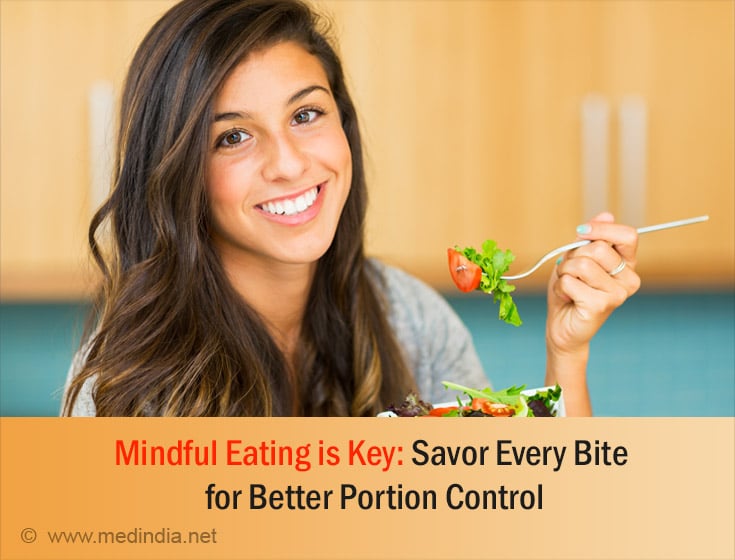- Effects of Food Plate Size and Color on Visual Perception of Satiety in Adolescents; a New Strategy toward Weight Management - (https://www.ncbi.nlm.nih.gov/pmc/articles/PMC10362832/)
- Mindful Eating: The Art of Presence While You Eat - (https://www.ncbi.nlm.nih.gov/pmc/articles/PMC5556586/)
- Meal planning is associated with food variety, diet quality and body weight status in a large sample of French adults - (https://pubmed.ncbi.nlm.nih.gov/28153017/)
- The effects of water temperature on gastric motility and energy intake in healthy young men - (https://pubmed.ncbi.nlm.nih.gov/30617417/)
- Eating attentively: a systematic review and meta-analysis of the effect of food intake memory and awareness on eating - (https://www.ncbi.nlm.nih.gov/pmc/articles/PMC3607652/)
- MyPlate, Half-Plate, and No Plate: How Visual Plate-Related Dietary Benchmarks Influence What Food People Serve - (https://www.ncbi.nlm.nih.gov/pmc/articles/PMC9214582/)
- The relationship of eating until 80% full with types and energy values of food consumed - (https://pubmed.ncbi.nlm.nih.gov/25794479/)
About
Let’s be honest: we’ve all been there. You are sitting at the dinner table, enjoying a delicious meal, and before you know it- bam! - you’ve eaten three servings, and you are contemplating a fourth. While indulging occasionally is not a big deal, making overeating a habit can lead to unwanted weight gain, sluggishness, and even long-term health problems. But here is the good news: you don’t have to give up your favorite foods. With a few foolproof strategies, you can enjoy your meals, control portion sizes, and stop overeating once and for all. Not only will these tips help you manage your eating habits, but they will also fool proof your fitness goals!
Did You Know?
Eating with your non-dominant hand can actually reduce how much you eat by making you more mindful and slowing you down!
Top 10 Tips to Stop Overeating
Whether you have been guilty of eating an entire bag of chips in one sitting or you’re simply looking to practice more mindful eating, here are the top ways to regain control over your portions and avoid overeating. These tips are essential if you are aiming for portion control for weight loss or simply maintaining a healthy diet.
Use Smaller Plates and Bowls
Did you know the size of your plate can trick your brain into thinking you have eaten more than you actually have? Studies show that people tend to eat less when they serve food on smaller plates because a full small plate looks more satisfying than a half-empty large one(1✔ ✔Trusted Source
Effects of Food Plate Size and Color on Visual Perception of Satiety in Adolescents; a New Strategy toward Weight Management
Go to source). Try swapping out your regular dinnerware for smaller plates and bowls, and you might be surprised by how much less food you consume.
Why This Matters: It is all about visual cues- your brain registers a full plate as “enough,” even when the portion is smaller! This is a simple and effective portion size guide for adults and children alike.
Practice Mindful Eating
Eating should be a sensory experience, not something you rush through while watching Netflix. Mindful eating is all about paying attention to your food- the flavors, textures, and how full you are feeling- so you can eat more slowly and stop when satisfied, not stuffed. Put down your phone, chew slowly, and savor every bite. It not only helps with portion control for weight loss but also makes your meals far more enjoyable(2✔ ✔Trusted Source
Mindful Eating: The Art of Presence While You Eat
Go to source).
Why This Matters: When you slow down and tune into your body’s hunger and fullness cues, you will naturally eat less and feel more satisfied.
Plan Your Meals in Advance
We are all guilty of ordering takeout or hitting the snack drawer when we’re too tired to cook. However, spontaneous eating often leads to oversized portions and poor food choices, contributing to overeating and even eating disorders. By planning your meals ahead of time, you can decide exactly what and how much to eat, reducing the chances of overeating(3✔ ✔Trusted Source
Meal planning is associated with food variety, diet quality and body weight status in a large sample of French adults
Go to source). Meal prepping for the week or simply planning out your daily meals can be a lifesaver when hunger hits.
Why This Matters: With a game plan in place, you’re less likely to make impulsive, calorie-heavy decisions.
Drink Water Before Meals
Feeling hungry? Sometimes, that 'hunger' is actually thirst in disguise. Drinking a glass of water 30 minutes before a meal can fill your stomach, making you less likely to overeat(4✔ ✔Trusted Source
The effects of water temperature on gastric motility and energy intake in healthy young men
Go to source). Not only will this help with portion control, but it also ensures you’re staying hydrated- an added bonus!
Why This Matters: Hydration keeps false hunger at bay, preventing you from overindulging in unnecessary calories.
Eat High-Volume, Low-Calorie Foods
If you want to feel full without overeating, the trick is to fill up on foods that are high in volume but low in calories. Vegetables, fruits, and broth-based soups are excellent examples of this. They are packed with nutrients but won’t weigh you down with extra calories, allowing you to eat more without the guilt.
Why This Matters: You get to eat larger portions while consuming fewer calories, keeping you full longer and satisfied- a key aspect of any portion size guide for adults and children.
Limit Distractions During Meals
How many times have you zoned out in front of the TV or scrolled through your phone, only to realize you’ve finished an entire meal without even tasting it? Eating while distracted makes it easy to lose track of how much food you’re consuming, leading to overeating(5✔ ✔Trusted Source
Eating attentively: a systematic review and meta-analysis of the effect of food intake memory and awareness on eating
Go to source). Make it a rule to sit down and focus on your food, so you stay mindful of your portion sizes.
Why This Matters: When you are fully present while eating, you will be more aware of when you are truly full and satisfied.
Use the 'Half-Plate' Rule
If you’re someone who struggles with knowing how much is too much, the 'half-plate' rule can be a game changer. Fill half your plate with vegetables, one-quarter with protein, and one-quarter with whole grains(6✔ ✔Trusted Source
MyPlate, Half-Plate, and No Plate: How Visual Plate-Related Dietary Benchmarks Influence What Food People Serve
Go to source). This helps ensure that you’re getting a balanced meal while keeping your portions in check.
Why This Matters: You will automatically reduce calorie intake by focusing on nutrient-dense, lower-calorie foods.
Serve Yourself a Single Portion
One of the most common causes of overeating is serving food family-style- where you keep dishes on the table and help yourself to seconds (or thirds). Instead, serve yourself a single portion on your plate, and leave the rest in the kitchen. This small change makes it less tempting to go back for more food.
Why This Matters: Out of sight, out of mind! Keeping extra portions away helps curb the impulse to overeat.
Snack Smart
Snacking is not the enemy- mindless snacking is! If you feel hungry between meals, opt for healthy snacks like fruits, nuts, or yogurt, but pre-portion them before you start eating. For example, instead of reaching into a bag of chips, pour a single portion into a bowl. This helps prevent overeating and makes you more aware of your snack intake.
Why This Matters: Portion control is not just for meals- snacks count too! Pre-portioned snacks prevent you from overindulging.
Stop Eating When You’re 80% Full
One of the best tips to avoid overeating is to stop eating when you feel about 80% full. It takes about 20 minutes for your brain to register that you are full, so stopping at 80% gives your body time to catch up. This helps prevent that post-meal discomfort that comes with overeating(7✔ ✔Trusted Source
The relationship of eating until 80% full with types and energy values of food consumed
Go to source).
Why This Matters: By stopping before you are completely full, you avoid overeating and stay comfortable after meals.

Advantages and Disadvantages of Portion Control
Portion control is a powerful tool, especially when aiming to fool proof your fitness goals or manage weight effectively. However, like any strategy, it has its pros and cons.
Advantages:
- Weight Management: Portion control for weight loss is one of the most effective strategies to manage and reduce weight over time.
- Mindful Eating: Helps cultivate better eating habits by encouraging you to pay attention to hunger and fullness cues.
- Balanced Nutrition: Ensures that you’re getting a balanced diet with the right proportions of different food groups.
Disadvantages:
- Restrictive: For some, portion control might feel overly restrictive and can lead to feelings of deprivation, potentially triggering eating disorders.
- Difficult to Maintain: Consistently measuring and controlling portions can be time-consuming and challenging to maintain long-term.
- Potential Nutrient Deficiency: If not done properly, portion control could lead to under-consumption of certain nutrients, particularly in children.
Mastering Portion Control and Stopping Overeating
Overeating is easy to fall into, but with these fool proof tips, you can regain control over your portion sizes without sacrificing the joy of eating. Whether you start by using smaller plates, drinking water before meals, or practicing mindful eating, these strategies can help you stop overeating and feel more in control of your health. By mastering portion control, you’re not just avoiding overeating; you’re setting the stage to fool proof your fitness goals and promote long-term well-being for both adults and children.
So, go ahead and enjoy your meals- just in the right portions!









